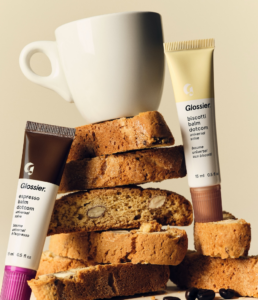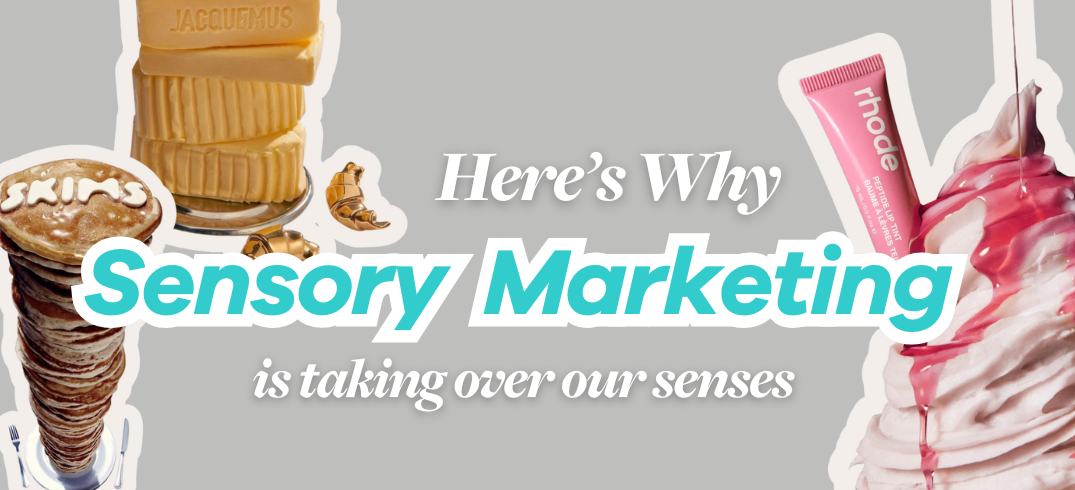But First, What is Sensory Marketing?
Whether you have or haven’t heard the term, sensory marketing is making an impact. The term is used to describe marketing campaigns that target each and any of the five senses. If you’ve seen any cool campaigns floating around, like Jacquemus’ recent bread and butter campaign, then you probably know what we’re talking about.
Sensory marketing campaigns are generally used by e-commerce brands, but the method doesn’t discriminate and can be a great way to capture your audience’s eyes (and the rest of their senses).
Here is why sight, sound, taste, touch and smell should be all the rage when it comes to your next marketing campaign.

The Psychology Behind Sensory Marketing?
Marketing that has the power to engage our senses also has the power to change our perception. For example, the latest Glossier campaign involving their Espresso & Biscotti Balm Dotcom, uses the sensory cue of biscotti bread and espresso beans. The food is photographed alongside the lip balm duo to signify their sensory appeal as being similar to the food they have been placed beside.
So what does this psychologically signify? Instantly, we can smell this product and feel it. It places us into the environment in which it has also been placed. We, as consumers, are fully immersed in the world of this product. Our perception of it has been completely altered.
We’ve engaged with the product without actually purchasing it. Which brings us to why this is so important.

Why It Matters for Marketers
Sensory marketing shapes the journey of the consumer using the power of the subconscious. Using the sensory cues of a product to drive its appeal can prove to be extremely effective. In short: it works!
The feeling that these types of ads provoke can leave the consumer with a new want to have this product, even if they don’t necessarily need it. Sensory marketing is particularly effective for industries, such as beauty and fashion, that are highly competitive and saturated. Appealing to a consumer’s senses can justify a purchase by enforcing a stronger emotional connection to the product.
It also stays in the mind of the consumer. They are reminded of it when they go out to purchase their next coffee and their lips are suddenly feeling dry from the caffeine they’ve just drunk. Suddenly, they become reminiscent of Glossier’s espresso balm and they’re one step closer to purchasing the product itself.
These campaigns are memorable because they cleverly tie themselves into the world around us. We’re reminded of them as we go about our day-to-day lives.
How to Respond or Take Advantage
Now that we know just how effective this form of marketing can be, how can you repurpose it for your own campaigns?
There is no one step method in creating an effective sensory marketing campaign. However, there are some great approaches that can better suit your brand and/ or product, including:
- Choosing one of the five senses that can be most easily associated with your brand i.e. a lawn mower brand might use the scent of freshly mowed grass. It’s better to stick to one or two rather than all five, giving your consumer sensory overload. Yikes!
- Know your niche and customise your sensory cue to appeal to your target market i.e. luxury brands might want to focus on the emotional response of exclusivity and individuality from owning their product.
- Be conscious of choosing a cue that either visually compliments or contrasts your product i.e. a vanilla sponge cake will compliment a product that has a similar scent and give them a snapshot of that product. On the other hand, it may be good for a shaving company to use spikey imagery (like a cactus) that contrasts the final result of their product. It hits a pain point by showing the problem at hand while also providing a solution.
Key Takeaways
Sensory marketing can be a super fun and important way to market your product. It creates a relationship between consumer and brand before they’ve even seen the real thing. This form of marketing is a great reminder that sensory immersion can be that extra step your customer journey needs to drive conversion and sales.
But, be cautious. Like with any marketing, there are right and wrong ways to do it that depend entirely on the product you’re marketing.
This is your official sign to head to the drawing board to see what you can come up with.




